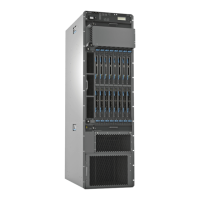Figure 25: C2600 Routing Engine
5—1— USB LEDExtractor clips
6—2— Offline buttonSSD and CompactFlash card slot cover
7—3— Online LEDLEDs
8—4— Reset buttonUSB port
The faceplate of the Routing Engine contains the following:
•
USB port USB—Provides a removable media interface through which you can install
the Junos OS manually. The Junos OS supports USB versions 2.0 and 1.1.
•
CompactFlash card slot CF—Provides primary storage for software images,
configuration files, and microcode.
•
Two solid-state disk slots SSD1 or Disk 1 and SSD2 or Disk 2—Provide secondary storage
for log files, memory dumps, and rebooting the system if the CompactFlash card fails.
NOTE: SSD2 or Disk 2 is not currently supported.
•
Reset button—Reboots the Routing Engine when pressed.
•
Offline button—Takes the Routing Engine offline when pressed.
•
Extractor clips—Control the locking system that secures the Routing Engine.
•
LEDs—“PTX5000 Routing Engine LEDs” on page 47 describes the functions of these
LEDs.
NOTE: For specific information about Routing Engine components (for
example, the amount of DRAM), issue the show chassis routing-engine
command.
Routing Engine Boot Sequence
The Routing Engine boots from the storage media in this order: the USB device (if present),
the CompactFlash card CF (if present), the disk (if present) in slot 1 SSD1, the disk (if
present) in slot 2 SSD2, then the LAN.
NOTE: SSD2 is not currently supported.
Copyright © 2012, Juniper Networks, Inc.46
PTX5000 Packet Transport Switch Hardware Guide

